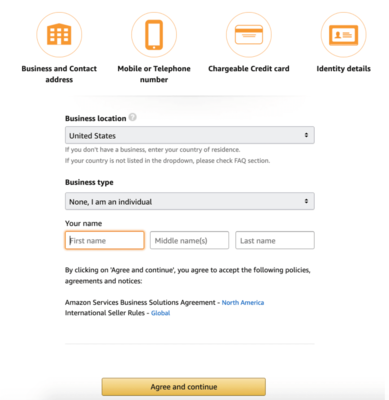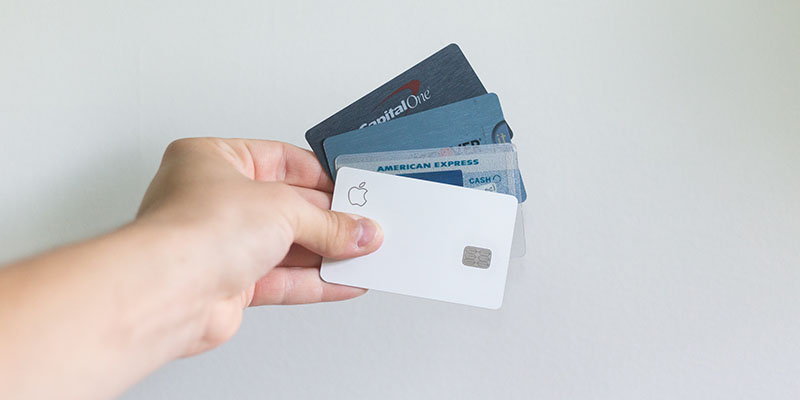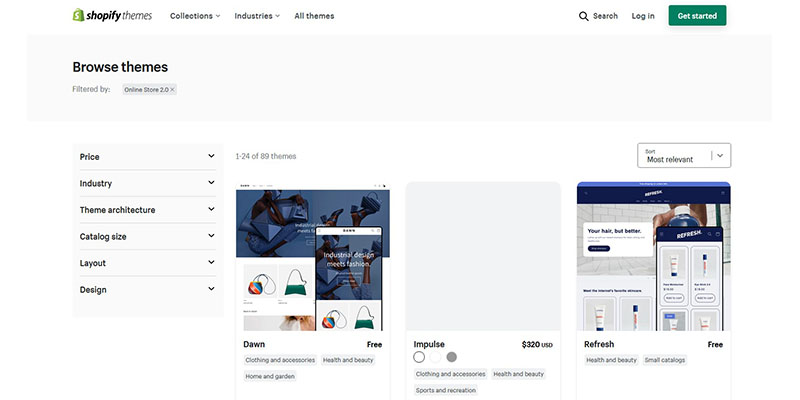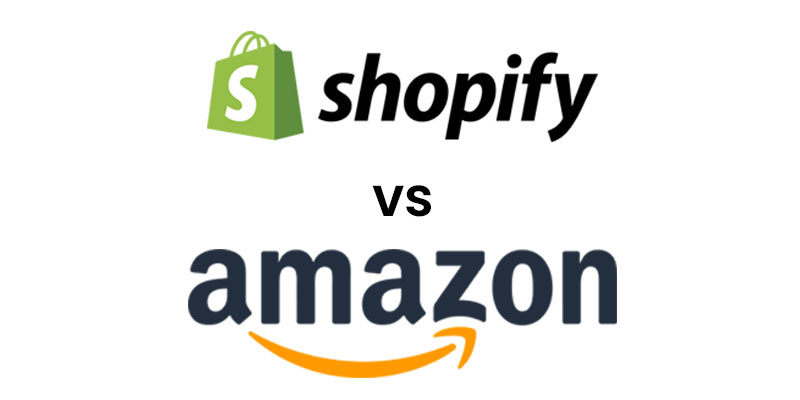Shopify and Amazon are two of the top leaders in the ecommerce world. Both help you display your products in front of millions of potential customers, but they are completely different services.
Shopify is an ecommerce platform that lets you build an online store without code. In contrast, Amazon is an online marketplace where you sell your products alongside other sellers.
If you’re looking to sell your goods online, you’re probably comparing Shopify vs Amazon as both platforms have their pros and cons.
In this post, I compare Shopify vs Amazon in detail based on…
- Ease Of Use – Which platform is easier to get started?
- Pricing – Which platform is cheaper?
- Payment Options – Which platform offers more payment options?
- Design Flexibility – Which platform offers more design flexibility and freedom?
- Support – Which platform offers better customer support?
- Ecommerce Features – Which platform offers better ecommerce selling features?
- Traffic And Sales – Which platform will generate you more traffic and sales?
Get My Free Mini Course On How To Start A Successful Ecommerce Store
If you are interested in starting an ecommerce business, I put together a comprehensive package of resources that will help you launch your own online store from complete scratch. Be sure to grab it before you leave!
Shopify Vs Amazon: What Are The Differences?
The primary difference between Shopify vs Amazon is that Shopify is an ecommerce platform, and Amazon is an online marketplace.
With Shopify, you can easily create an online store where you have the flexibility to design the front end and sell whatever you want.
You can build an ecommerce brand from the ground up with Shopify. However, you’ll need to learn how to market your brand and drive traffic to your website.
Amazon is an online marketplace that attracts 231 million unique monthly visitors in the US. By listing your product on Amazon, your product instantly becomes visible to hundreds of millions of users without having to learn how to drive your own traffic.
However, you’re only allowed to sell products on Amazon that adhere to their guidelines. In addition, certain categories require Amazon’s approval before selling, such as fine art, music, and jewelry.
Selling on Shopify is like renting a commercial building for your business. You have your own space and can use it however you want. But you’ll need to advertise its location so that people can find you.
Selling on Amazon is more like renting a small store in a mall. Thousands of potential customers visit your store when they’re shopping at the mall. Although they aren’t explicitly looking for your business, you will make sales because of the high foot traffic.
Simply put, Amazon works best for individual sellers and small businesses who want a faster ramp up to sales. Shopify is the perfect solution for businesses who want to own their own brand and website.
Click Here To Try Shopify For Free
Shopify Vs Amazon: Pros And Cons
Shopify Pros
- User-friendly eCommerce platform: You don’t need any coding skills to build a Shopify website. It’s easy to use and has an intuitive admin interface. Additionally, there’s plenty of documentation available to guide you through the setup process.
- Highly customizable: You can choose one of Shopify’s 80+ themes or third-party templates to design your professional store. You can then use their drag-and-drop design editor to customize your website layout.
- Provides powerful ecommerce tools: Shopify gives you access to 7000+ apps that aren’t available to Amazon sellers. For example, Shopify has an app called “Point of Sale” that unifies your online and offline stores by managing sales, payments, and returns, among other things. Shopify also has ecommerce tools such as abandoned cart recovery, coupons, and discounts.
- Easy to create a unique brand identity: With Shopify, you can create a unique brand identity as you have full control over your product display and branding.
- Multiple payment options: Amazon can’t compete with Shopify when it comes to payment gateways. Shopify offers more than 100 payment options, such as PayPal, Apple Pay, Stripe, and Amazon Pay. Shopify also has an in-house payment gateway where there are no transaction fees.
- Fewer restrictions: Shopify has no restrictions on what you can sell using their platform except for firearms and other dangerous or illegal products.
- Highly scalable: Shopify is designed to be suitable for online stores of all sizes. It hosts world-famous brands such as Heinz and Kylie Cosmetics.
Shopify Cons
- Marketing costs: With Shopify, you’re fully responsible for building brand awareness and driving traffic to your website. You’ll need to learn how to use Google Ads, Facebook Ads, and social media to advertise your products and build a customer base.
- Expensive to start: It’s more costly to start selling on Shopify than on Amazon, as the cheapest Shopify pricing plan starts at $29/month. Installing third-party apps to add ecommerce functionality further increases your initial setup costs.
Amazon Pros
- High traffic: Starting an online store from scratch and driving traffic to it requires marketing investment. As Amazon attracts millions of shoppers each month, it gives your products instant exposure. With high traffic and superior conversion rates, selling on Amazon is much easier to start.
- Hassle-free setup: Amazon’s user interface is simple and easy to use. You’ll only need to follow a few steps to start selling on Amazon, such as providing account details and adding product images and descriptions.
- Amazon FBA: Amazon has a unique program called Fulfillment by Amazon (FBA), which handles storing, packing, and shipping your products at low costs. Having Amazon FBA makes it easier to run your business.
- Confident buyers: Since shopping online can be a hit-or-miss experience, shoppers are hesitant to purchase from unknown stores. Because Amazon is a household name, you benefit from their reputation and brand authority.
- Low financial risk: It’s significantly less expensive to start selling on Amazon vs Shopify. You can start selling on Amazon for free.
Amazon Cons
- High competition: There are more than 10 million Amazon sellers and over 2 million are from the US alone. The competition is fierce and there’s rampant piracy on the platform. Standing out on Amazon is extremely difficult.
- Limited payment options: Amazon doesn’t support third-party payment gateways like Stripe or PayPal. They have an in-house gateway called Amazon Pay which only accepts credit and debit cards.
- Limited Access To Your Customers: Amazon owns all of your customer data so you can’t do email marketing, SMS Marketing, or direct mail marketing. As a result, it’s extremely difficult to generate repeat sales.
- Product restrictions: Amazon has a lot of restrictions on what you can sell and what you can’t. They also restrict specific categories such as watches, jewelry, and sports collectibles. You’ll need to contact Amazon directly for approval.
Shopify Vs Amazon: Ease Of Use
Getting started selling on Amazon is much easier than Shopify because you don’t have to build an entire website from scratch.
To sell on Amazon, you simply need to register for an account and list your products.
Setting up an online store on Shopify is easy as well. Like Amazon, Shopify has a guided wizard that walks you through the setup process one step at a time.
However, there’s a steeper learning curve with Shopify as you need to set up your domain, theme, shipping, payment provider, taxes, etc.
That said, both platforms are intuitive and offer a minimalist design, easy navigation, and tutorials to help you get started. Shopify and Amazon are designed to be straightforward to set up for new ecommerce sellers.
But in terms of ease of use and getting started, Amazon wins hands down.
Winner: Amazon
Shopify Vs Amazon: Pricing
Due to Amazon’s high fees, selling on Amazon is more expensive than Shopify once your business generates a steady stream of sales. However, Shopify costs more to set up than Amazon when you are first getting started.
Shopify offers a 14-day free trial and 6 pricing plans as follows:
- Shopify Starter — $5 per month. This plan has design-ready product pages and checkout. You don’t get an online store with this plan, but you get a link that you can share through social media, email, SMS, and other platforms.
- Shopify Lite — $9 per month. This plan doesn’t include an online store. You can only embed a Buy Button on your existing website or blog. Unfortunately, this plan isn’t available in the US and 4 other countries.
- Basic Shopify — $29 per month + 2.9% + 30¢ per transaction. This entry-level plan has limited features. It’s ideal for first-time sellers who are trying to figure out how to sell online.
- Shopify (Regular) — $79 per month + 2.6% + 30¢ per transaction. This is the most popular Shopify plan with a few additional features over the basic plan and is great for small to medium businesses.
- Advanced Shopify — $299 per month + 2.4% + 30¢ per transaction. The advanced plan has more features than Shopify (regular) plan, such as third-party calculated shipping rates and lower transaction fees.
- Shopify Plus — $2000+/month + 2.15% and 30¢ per transaction. Shopify’s enterprise ecommerce plan is for large businesses doing multiple millions in sales.
All these plans (except Shopify Starter) give you access to core ecommerce features such as site security, discount codes, unlimited product listings, and credit card processing.
On the other hand, Amazon offers two plans as follows:
- Individual: The individual plan has no monthly subscription fees, but you must pay $0.99 per item sold. You can not advertise or take part in Amazon Brand Registry. This plan is suitable for sellers testing the waters before choosing to go all in on Amazon.
- Professional: This plan has a monthly subscription fee of $39.99. You get access to more advanced tools such as promotions, Amazon ads, and inventory management, which are essential for running a successful Amazon store.
In addition to the above costs, Amazon also charges a “referral fee” for every product sold. The referral fee depends on the product category, but is usually 15%.
If you choose to use Fulfillment By Amazon, you’ll have to pay another $2.92 to $150.94 per unit, depending on the package weight, size, and time of the year.
The cost of selling on Shopify vs Amazon depends on your sales volume.
If you’re making $100 in monthly sales, then Amazon will cost you $15 which is cheaper than Shopify. But if you’re generating $10,000 in monthly sales, you’ll end up paying $1500 to Amazon which is far greater than Shopify.
Because of Amazon’s high referral fees, Shopify is a cheaper alternative for selling in larger volumes. However, you must also factor in the additional costs of marketing and sales when you run a Shopify store.
Winner: Draw
Shopify Vs Amazon: Payment Options
Shopify offers many more payment options than Amazon with greater flexibility. For example, Shopify allows you to accept Paypal whereas Amazon does not.
Shopify also has its own payment gateway called Shopify Payments which does not charge any transaction fees.
Technically, Amazon does not charge extra fees for payment processing because the cost of payment processing is encapsulated into the 15% referral fee you pay when you make a sale.
However, Amazon’s payment processing options are extremely limited because you can not accept PayPal, Apple Pay, Google Pay or any other payment gateways.
In contrast, Shopify supports 100+ payment gateways, including Amazon, PayPal, Stripe, and Apple Pay. These payment gateways have a transaction fee ranging from 0.05% to 2%, depending on the plan and payment option.
For credit card payments, a separate credit card rate is applicable, which is around 2.9% + 30¢ to $2.4% + 30¢, depending on the plan.
Winner: Shopify
Shopify Vs Amazon: Design Flexibility
Shopify is significantly more flexible than Amazon when it comes to design and you have full control over your website and the presentation of your products.
Designing your website is simple. Shopify provides access to 88 beautiful themes which can be edited and personalized according to your brand.
You can also find attractive ecommerce themes on digital marketplaces like Out Of The Sandbox, Theme Forest and Template Monster.
Shopify gives you complete control over your website design and every aspect of your site is fully customizable. On the other hand, Amazon offers no room for customization and every Amazon listing looks the same.
All Amazon pages have a similar layout and design making it easy for sellers to create product listings and sell right away.
However, uniformity across all pages makes it difficult for you to stand out from the competition.
Overall, Shopify wins hands down when it comes to creating a unique brand image and having the freedom to design your own online store.
Winner: Shopify
Shopify Vs Amazon: Support
Shopify offers much better support than Amazon hands down. Amazon is notorious for outsourcing their customer support to India and other non-English speaking countries and they often provide canned responses that are not helpful.
There is no phone number to be found on Amazon’s website and you have to struggle to reach a customer support representative over the phone.
In contrast, Shopify offers 24/7 phone and email support and they have tons of articles, video tutorials, and guides that cover everything you need to know about Shopify.
The Shopify Help Center is easy to browse and navigate. In addition, Shopify offers an extensive set of support options such as:
- Forum
- 24/7 phone
- 24/7 live chat
- Social media
- Advanced specialist support
Their 24/7 support is always accessible for all merchants regardless of plan.
Like Shopify, Amazon has a Help Center that answers frequently asked questions. Amazon also has a forum where you can submit queries and discuss issues with fellow merchants.
But in order to get anyone on the phone, you must request a call using the “Contact us” button. This button is often hidden because Amazon encourages its sellers to resolve their issues using resources such as forums, help pages, and tutorials.
Overall, Amazon support is horrible and you’ll end up wasting countless hours trying to get a straight answer from a non-native English speaking support rep.
Winner: Shopify
Shopify Vs Amazon: Ecommerce Selling Features And Tools
Shopify offers more ecommerce selling features than Amazon but this is largely because Amazon is less flexible and does not provide you with your customer’s information.
Both Shopify and Amazon have powerful built-in features that help you manage your ecommerce business efficiently.
For example, Shopify offers the following tools:
- Abandoned cart recovery to retarget customers who didn’t complete the checkout process.
- Inventory tracking system to manage inventory and shipping more efficiently.
- Coupons and discounts to entice customers to buy.
- Logo maker to create logo designs.
- Point of sale to take orders at trade shows and flea markets.
You can also add live chat, customer loyalty programs, email marketing, SMS marketing, and many more tools designed to retain your customers and generate repeat business..
With more than 7000 apps in its marketplace, the Shopify App Store has a solution for all your ecommerce needs.
If you’re a dropshipper, Shopify offers many apps that automatically import products from AliExpress into your online store.
Like Shopify, Amazon also offers many selling tools that make doing business easy. But Fulfillment by Amazon is by far Amazon’s best feature.
With FBA, Amazon will store, pack, and ship your products so you don’t have to worry about inventory.
All you have to do is send your products to an Amazon warehouse and Amazon does the rest. There is a fee for FBA, but it saves the headache of inventory management, shipping, and returns.
Both Amazon and Shopify possess a unique set of ecommerce features and tools which aren’t found in the other. So, it’s a tie.
Winner: Draw
Shopify Vs Amazon: Generating Traffic And Sales
Amazon has a massive advantage over Shopify when it comes to generating traffic and sales. Because Amazon gets 2.45 billion monthly visitors in the US alone, you can get instant exposure for your products to a huge audience.
The only drawback with Amazon is that the competition is fierce and you must convince shoppers to buy from you over your competitors.
When you build a store on Shopify, you’re starting from ground zero. Your website won’t have any traffic so you’ll need to generate your own sales with:
- Google Ads
- Facebook Ads
- Search engine optimization
- Email marketing
- SMS marketing
- Blogging
Learning these skills takes time, and there’s a significant learning curve. However, your website allows you to own your customers and Shopify provides various marketing tools that give you complete control over your brand to attract repeat business.
With Amazon, many customers will buy from you but you’ll never know who they are which makes it difficult to build a brand.
But in terms of sheer traffic and sales, Amazon wins hands down due to its massive customer base.
Winner: Amazon
Shopify Vs Amazon: Search Engine Optimization
If you compare Shopify vs Amazon in terms of search engine optimization (SEO), Amazon has a superior advantage. Here’s why.
When you build a store on Shopify with a new domain, you have little or no domain authority, which makes it difficult for you to rank on Google search.
You must learn how to optimize your pages for the search engines and create content to rank on Google, which can be time-consuming.
But when you list your products on Amazon, they can rank on the front page of Google right away. This is because Amazon has high domain authority and their listings carry massive weight with the search engines.
If you list a product on Shopify and Amazon at the same time, the chances of ranking on Google are much higher with your Amazon listing.
In addition, Amazon runs its own search engine, which drives traffic and ecommerce sales for over 50% of the US. Overall, if you understand both Amazon SEO and Google SEO, you will be successful.
Winner: Amazon
When To Use Shopify Vs Amazon
Here’s a quick overview of Shopify vs Amazon:
- Shopify is an ecommerce platform and Amazon is an online marketplace.
- With Amazon, it’s cheaper to start your online business but it can get more expensive as your sales volume increases.
- Amazon owns your customer base, making it challenging to build a brand.
- Shopify offers design flexibility and lets you customize your store however you want with no restrictions.
- Shopify has better customer support than Amazon.
- Both Shopify and Amazon offer useful ecommerce features. Shopify has abandoned cart recovery, dropshipping, email/SMS marketing and customer loyalty programs. Amazon has Fulfillment by Amazon, one of the world’s most advanced fulfillment networks.
The decision to sell on Shopify vs Amazon depends on your budget and sales goals.
Choose Shopify if:
- You want to build your own brand and a scalable ecommerce business.
- You want to own your custom domain.
- You don’t want restrictions on how to design your website.
- You have the time to learn about SEO and other marketing strategies.
- You’re willing to put in the effort to build a loyal customer base.
Click Here To Try Shopify For Free
Choose Amazon if:
- You want to make money as quickly as possible.
- You’re on a limited budget.
- Your focus is not on building a brand.
- You don’t want the hassle of managing inventory, packaging, and shipping products.
Click Here To Learn How To Sell On Amazon
Integrate Amazon With Shopify
When is comes to evaluating Shopify vs Amazon, you should eventually sell on both platforms to maximize your sales and reach. In fact, you can easily integrate Amazon with your Shopify store.
The Shopify Amazon app allows you to own your own ecommerce business and promote your products to millions of customers on Amazon with just a few clicks.
Here’s what you need.
- Install the Shopify Amazon Integration app.
- Sign up for an Amazon Professional Seller account.
- Add the Amazon Sales Channel to your Shopify online store.
The Shopify Amazon integration lets you sync inventory, link products, and fulfill orders from the same dashboard.
You can also have your Shopify store orders ship directly from an Amazon warehouse via FBA. This is called Amazon multi-channel fulfillment.
The Best Ecommerce Platform For You
My recommended flow for new ecommerce entrepreneurs is to start out selling on Amazon and then transition to your own Shopify store once you’ve validated your product.
If you’re on a budget and don’t want to invest in marketing or designing a website, then start with Amazon.
Once your Amazon store generates some sales and you get decent traffic, you should consider setting up a Shopify store to start building your brand.
With Shopify, you can collect customer data and use it to grow your customer base.
Ultimately, your goal should be to sell on as many platforms as you can to maximize your reach.

Ready To Get Serious About Starting An Online Business?
If you are really considering starting your own online business, then you have to check out my free mini course on How To Create A Niche Online Store In 5 Easy Steps.
In this 6 day mini course, I reveal the steps that my wife and I took to earn 100 thousand dollars in the span of just a year. Best of all, it's free and you'll receive weekly ecommerce tips and strategies!
Related Posts In Ecommerce Platforms
- Choosing The Best Ecommerce Platform – Frequently Asked Questions
- How To Choose The Best VPS Hosting – Virtuozzo Or OpenVZ Vs Xen Vs KVM
- Shopify Vs Shopify Plus – Is The Upgrade Worth The Money?
- BigCommerce Vs Shopify – A Comprehensive Review And Comparison
- Top 8 Shopify Alternatives That Are Cheaper And Better

Steve Chou is a highly recognized influencer in the ecommerce space and has taught thousands of students how to effectively sell physical products online over at ProfitableOnlineStore.com.
His blog, MyWifeQuitHerJob.com, has been featured in Forbes, Inc, The New York Times, Entrepreneur and MSNBC.
He's also a contributing author for BigCommerce, Klaviyo, ManyChat, Printful, Privy, CXL, Ecommerce Fuel, GlockApps, Privy, Social Media Examiner, Web Designer Depot, Sumo and other leading business publications.
In addition, he runs a popular ecommerce podcast, My Wife Quit Her Job, which is a top 25 marketing show on all of Apple Podcasts.
To stay up to date with all of the latest ecommerce trends, Steve runs a 7 figure ecommerce store, BumblebeeLinens.com, with his wife and puts on an annual ecommerce conference called The Sellers Summit.
Steve carries both a bachelors and a masters degree in electrical engineering from Stanford University. Despite majoring in electrical engineering, he spent a good portion of his graduate education studying entrepreneurship and the mechanics of running small businesses.





















